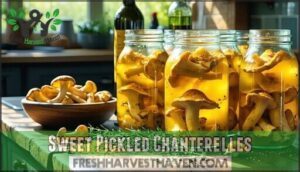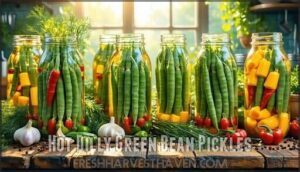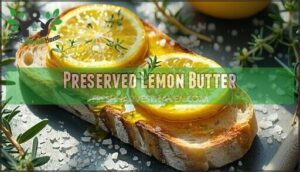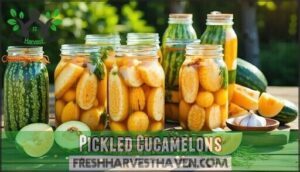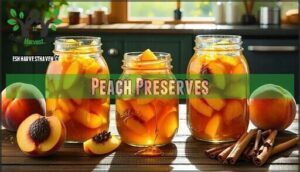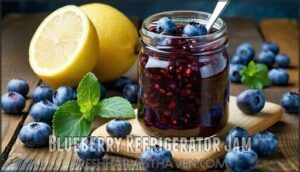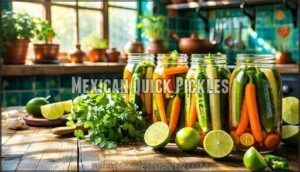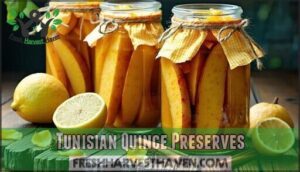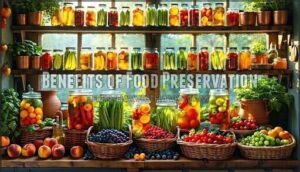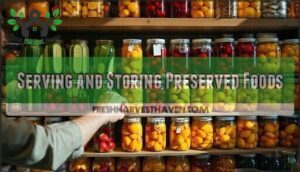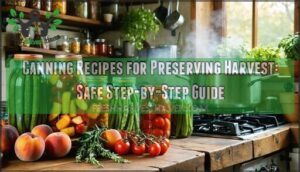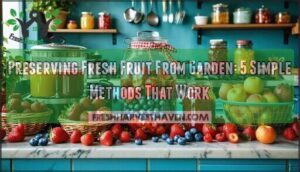This site is supported by our readers. We may earn a commission, at no cost to you, if you purchase through links.
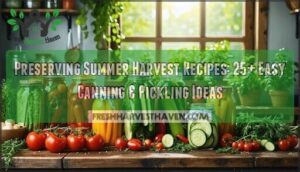
Preserving summer harvest recipes transform your fresh produce into pantry gold that’ll brighten winter meals.
Start with simple water bath canning for high-acid foods like pickles and jams. Your grandmother’s mason jars aren’t just decoration – they’re your ticket to capturing summer’s peak flavors.
Try classic dill pickles, strawberry preserves, or tangy pickled beets. Each jar becomes a time capsule of sunny days.
The secret lies in balancing acidity levels and processing times for safe, delicious results that’ll impress your family, and the key to this is creating a perfect balance to achieve delicious results with the right processing times.
Table Of Contents
- Key Takeaways
- Summer Harvest Preservation
- Food Preservation Recipes
- Preserving Fruits and Vegetables
- Benefits of Food Preservation
- Serving and Storing Preserved Foods
- Frequently Asked Questions (FAQs)
- How do you preserve summer harvest?
- How do you preserve harvest?
- How to preserve recipes?
- What are the ingredients needed for preserving food?
- How do you preserve food?
- What are the different methods of preserving food?
- Should you preserve creamed peas?
- Can You preserve flour & dry goods?
- How do you preserve summer produce?
- How do you preserve harvested crops?
- Conclusion
Key Takeaways
- You’ll master three essential preservation methods: water bath canning for high-acid foods like jams and pickles, pressure canning for low-acid vegetables, and fermenting for probiotic-rich foods that boost gut health.
- You can transform your garden’s abundance into shelf-stable treasures using simple equipment like mason jars, proper sterilization techniques, and tested recipes that balance acidity levels for safe, delicious results.
- You’ll save money and reduce food waste by preserving peak-season produce when it’s cheapest and most flavorful, creating pantry staples that last months while extending your harvest’s shelf life.
- You can get creative with flavor combinations by experimenting with spice blends, trying international recipes like Mexican quick pickles or Tunisian quince preserves, and using your preserved foods in everything from sandwiches to desserts.
Summer Harvest Preservation
Summer’s abundance doesn’t have to end when the season fades if you master basic preservation techniques.
Transform fleeting summer flavors into year-round treasures with simple preservation magic.
You’ll transform fresh produce into shelf-stable treasures using simple methods like water bath canning for fruits and pickles, pressure canning for vegetables, fermenting for tangy flavors, and dehydrating for concentrated tastes.
Canning Methods
Mastering canning methods reveals summer’s bounty year-round. Water Bath canning works perfectly for high-acid foods like jams and pickles—simply submerge jars in boiling water.
Pressure Canning handles low-acid vegetables and meats at 240°F for canning safety. Start with Jar Sterilization using hot, soapy water or your dishwasher’s sanitize cycle.
Follow tested canning recipes exactly for Recipe Safety—never wing the measurements. Proper Storage Tips include removing rings and checking seals.
These food preservation techniques transform summer produce into pantry gold that’ll make winter meals sing.
Pickling Techniques
Beyond basic canning, pickling techniques reveal bold flavors that make your summer produce sing.
Master these brining methods to achieve perfect sweetness balance and crispness factors:
- Quick-pickle for immediate gratification using vinegar-based solutions
- Salt-brine for classic deli-style results with natural fermentation
- Spice infusions like dill, garlic, and mustard seeds for complexity
- Temperature control to maintain vegetable texture
Many recipes call for a specific spice combination.
These preserving techniques transform ordinary vegetables into tangy treasures that’ll outlast winter.
Fermenting Foods
Fermenting food transforms your summer produce into probiotic powerhouses that boost gut health.
This ancient preserving technique develops complex flavors while maintaining fermentation safety through beneficial microbial cultures. Fermented vegetables offer incredible health benefits and exceptional flavor development.
Start your fermenting journey with these essentials:
- Fresh vegetables – cabbage, cucumbers, or green beans
- Sea salt – creates the perfect brine environment
- Clean jars – proper containers guarantee successful fermentation
Dehydrating Fruits and Vegetables
Dehydrating offers another stellar way to lock in your garden harvest.
Equipment options range from electric dehydrators to your regular oven set low.
Master dehydration basics by slicing fruits and vegetables evenly for consistent drying.
Create fruit leathers from pureed berries or transform zucchini into crispy vegetable chips.
Many prefer using an electric food preserver for consistent results.
Storage methods involve airtight containers in cool, dark spaces.
You’re preserving summer flavors while preserving food without fancy gadgets or complicated steps.
Food Preservation Recipes
You’ll find these tested preservation recipes perfect for capturing summer’s peak flavors in your pantry.
Each recipe uses simple techniques that transform fresh ingredients into shelf-stable treasures you can enjoy all year long.
Sweet Pickled Chanterelles
Mushroom foraging pays off when you transform golden chanterelles into sweet pickled treasures.
You’ll dry-sauté these beauties first to preserve their firm chanterelle texture, then pickle them with white wine vinegar and aromatic pickling spices.
The sweetness balance comes from sugar and thyme, creating perfect serving suggestions for cheese boards or summer salads while preserving vegetables at their peak.
These pickled chanterelles are available at various online stores.
Hot Dilly Green Bean Pickles
Transform your garden’s fresh green beans into Hot Dilly Green Bean Pickles using the right pickling spice blend and crispness techniques.
Bean variety impact matters—choose tender young pods for best results.
Control heat level with jalapeños or red pepper flakes while maximizing dill flavor intensity.
These pickle recipes showcase excellent green beans preservation methods for preserving vegetables and your summer preserving harvest.
Preserved Lemon Butter
While pickled beans pack a punch, preserved lemon butter brings Mediterranean sunshine to your food preservation collection.
This canning recipes favorite transforms ordinary butter into liquid gold with preserved lemon’s bright tang.
Lemon Butter Uses span from breakfast toast to dinner’s grand finale:
- Perfect for spreading on warm sourdough bread
- Elevates grilled salmon and roasted asparagus
- Adds Mediterranean flair to pasta dishes
- Storage Tips keep it fresh for weeks
- Impresses guests with homemade sophistication
Pickled Cucamelons
These grape-sized Mexican sour gherkins bring serious flavor to your summer harvest collection.
Their cucamelon origin makes them perfect for pickling vegetables alongside traditional cucumber pickles.
Create your pickling brine with garlic and dill for the best texture profile.
Try recipe variations with different spices.
Use these tangy pickles as serving ideas for cocktails and sandwiches while preserving harvest goodness.
Preserving Fruits and Vegetables
You’ll transform fresh summer produce into shelf-stable treasures that capture peak flavors year-round.
These simple techniques help you preserve everything from sweet peach preserves to tangy pickled vegetables using basic kitchen equipment, which allows you to enjoy your favorite flavors throughout the year with basic kitchen tools.
Peach Preserves
Peach ripeness makes all the difference when crafting golden preserves that’ll have your family asking for more.
You’ll want fruit that gives slightly to gentle pressure but isn’t mushy.
Here’s your roadmap to peach preserve perfection:
- Test peach ripeness with a gentle squeeze
- Balance pectin levels with natural fruit sugars
- Experiment with spice pairings like cinnamon or vanilla
- Choose sugar types that complement peach flavor
- Master jar sealing techniques for safe food preservation
Blueberry Refrigerator Jam
Skip the complicated canning process and whip up this blueberry refrigerator jam instead.
You’ll love how fresh berries transform into spreadable gold with just sugar and lemon juice.
This homemade jam offers endless recipe variations—adjust sweetness levels to taste or swap pectin alternatives like chia seeds.
Perfect for preserving summer harvest flavors, your jam recipes will keep fresh for weeks, delivering fruit preservation without fuss.
Mexican Quick Pickles
Summer’s bounty transforms into Mexican quick pickles that pack serious flavor punch.
These spicy pickles capture your preserving summer harvest dreams perfectly.
Master the technique with these essentials:
- Vinegar Type Matters – white vinegar creates the sharpest bite
- Jalapeno Heat Level – adjust seeds for your spice tolerance
- Cilantro Lime Flavor – fresh herbs brighten every jar
Quick Pickling Tips and Pickle Spice Blends make Mexican pickles your new kitchen superpower!
Tunisian Quince Preserves
Moving from crisp Mexican pickles, you’ll love these Tunisian quince preserves that capture exotic flavors in every jar.
Different quince varieties work beautifully with traditional Tunisian spices like cinnamon and rose water.
This fruit preservation method creates silky preserve texture perfect for homemade preserves.
Canning fruit this way offers endless recipe variations and serving suggestions for your preserving harvest adventures.
| Ingredient | Quantity | Flavor Profile |
|---|---|---|
| Quince | 4-5 fruits | Tangy, floral |
| Sugar | 2 cups | Sweetness boost |
| Lemon | 1 fruit | Bright acidity |
| Cinnamon | 2 sticks | Warm spice |
| Rose water | 2 tbsp | Exotic essence |
Benefits of Food Preservation
You’ll discover that preserving food extends your summer harvest for months while cutting grocery costs and reducing waste.
These simple techniques let you create unique flavor combinations that turn ordinary meals into something special throughout the year, which helps in making your harvest last and reducing waste.
Flavor Retention
Proper flavor preservation transforms your preserving harvest into culinary gold.
Freshness Matters when you capture peak summer flavors at their ripest moment.
Processing Effects and Storage Conditions determine whether your homemade preserves maintain vibrant seasonal flavors.
Spice Impact intensifies during preservation, creating deeper taste profiles.
Smart Recipe Adjustments help you lock in those brilliant garden-fresh flavors year-round.
Cost Savings
Budget-friendly preservation transforms your wallet from empty to happy.
Bulk buying seasonal produce costs pennies compared to store prices year-round. You’ll create pantry staples through canning recipes and preserving summer bounty.
DIY gifts from your preservation efforts beat expensive store versions. Seasonal eating saves serious cash while preserving produce prevents waste.
Food preservation pays dividends.
Reduced Waste
Instead of tossing wilted greens or overripe tomatoes, you’ll transform them into treasures through preserving summer harvest techniques.
Food spoilage prevention becomes second nature when you master seasonal produce preservation. Extending shelf-life means fewer grocery runs and guilt-free pantries.
Turn leftover vegetables into pickles or jams while composting scraps that can’t be saved. Reducing packaging waste happens naturally when you preserve your own summer harvest.
Seed saving from preserved fruits creates next year’s garden, completing the circle of reducing food waste and ensuring a guilt-free pantry by extending the shelf-life and preventing food spoilage.
Creative Expression
Food preservation becomes your canvas for culinary creativity.
You’ll discover endless possibilities mixing flavors, textures, and presentation styles that reflect your personal taste.
- Flavor Experimentation – Blend unexpected ingredients like cardamom-infused peach preserves or jalapeño-strawberry jam
- Recipe Innovation – Transform traditional methods with modern twists and cultural fusion techniques
- Artistic Presentation – Create stunning jars that showcase your homemade artisanal foods beautifully
Serving and Storing Preserved Foods
You’ll want to know how to properly store your canned goods and use them in everyday meals to get the most from your preserving efforts.
Your homemade jams work great on toast while pickles add crunch to sandwiches, and proper storage keeps everything fresh for months.
Sandwiches and Burgers
Transform your sandwich spreads and burger toppings with preserved summer treasures.
Pickled relish adds crunch to turkey clubs, while tangy canning pairings like spiced peach chutney elevate grilled chicken sandwiches.
Spread homemade jam on burger buns for sweet-savory magic.
These seasonal recipes showcase fresh produce from harvest season, turning ordinary lunches into summer cooking masterpieces with homemade recipes.
Salads and Soups
Your preserved harvest transforms ordinary salads and soups into culinary masterpieces.
Pickled vegetables add tangy crunch to fresh greens, while canned ingredients create hearty winter soups.
Here’s how preserved foods elevate your meals:
- Pickled cucumbers bring bright acidity to leafy salads
- Canned tomatoes form the base for rich, warming soups
- Preserved peppers add smoky heat to seasonal recipes
- Fermented vegetables provide probiotics and complex flavors
Desserts and Baking
Your homemade strawberry jam and peach preserves aren’t just toast toppers – they’re dessert gold!
Create Canned Fruit Pies bursting with summer flavor or bake Jam-Filled Cookies that’ll wow guests.
Cherry preserves elevate Preserved Fruitcakes while blueberry preserves shine in Pickled Berry Tarts.
Dehydrated Fruit Leather adds chewy sweetness to any treat.
Preserving fruit means year-round dessert magic awaits!
Refrigerator and Pantry Storage
Smart storage temperatures make all the difference in preserving your summer bounty. Keep canned goods in cool, dark pantry spaces where shelf life extends up to two years. Your fridge handles fresh preserves best at 38-40°F in airtight containers.
Essential organization tips for success:
- Label jars with dates for easy rotation
- Store pantry staples away from heat sources
- Check regularly for spoilage signs like bulging lids
Proper jar placement and food storage methods guarantee your canning storage stays fresh longer.
Frequently Asked Questions (FAQs)
How do you preserve summer harvest?
Nearly 40% of home gardeners preserve their harvest to reduce food waste.
You’ll preserve summer’s bounty through canning, freezing, and pickling.
Start with water bath canning for high-acid fruits, then try pressure canning vegetables.
How do you preserve harvest?
You’ll preserve your harvest through canning, freezing, dehydrating, or fermentation.
Water bath canning works for high-acid foods, while pressure canning handles low-acid items.
Freezing retains nutrients, and dehydrating creates shelf-stable options.
How to preserve recipes?
Keep detailed notes of your canning adventures.
Document ingredient ratios, cooking times, and what worked best.
Store recipes in a waterproof binder or digital app you’ll actually use when your hands are sticky.
What are the ingredients needed for preserving food?
You’ll need a mountain of basic supplies to get started.
Grab fresh produce, canning salt, vinegar, sugar, pectin for jams, mason jars, lids, rings, plus essential tools like jar lifters and funnels.
How do you preserve food?
You’ll use three main methods: canning, freezing, and fermentation. Can high-acid foods in water baths, pressure-can low-acid items, freeze blanched vegetables, or ferment for tangy flavors.
What are the different methods of preserving food?
Food preservation offers several pathways to extend your harvest’s lifespan.
You’ll master canning, freezing, dehydrating, pickling, and fermentation.
Each method captures flavors differently, giving you year-round access to seasonal bounty through proven techniques.
Should you preserve creamed peas?
You shouldn’t preserve creamed peas using traditional canning methods.
The cream makes them low-acid, requiring pressure canning, but dairy products don’t preserve well.
Freeze plain peas instead, then add cream when cooking.
Can You preserve flour & dry goods?
You can’t preserve flour and dry goods through traditional canning methods. Instead, store them in airtight containers, cool places, or freezers to prevent pests and maintain freshness for months.
How do you preserve summer produce?
You can preserve summer produce through canning, freezing, dehydrating, and fermentation.
Water bath canning works for high-acid fruits, while pressure canning handles vegetables.
Freeze blanched vegetables and dehydrate herbs for year-round enjoyment.
How do you preserve harvested crops?
Make hay while the sun shines! You’ll preserve harvested crops through canning, freezing, dehydrating, or fermenting.
Choose water bath canning for high-acid foods, pressure canning for low-acid items, and freezing for quick preservation.
Conclusion
Like squirrels preparing for winter, you’ve now gathered the tools to transform your garden’s abundance into lasting treasures.
These preserving summer harvest recipes guarantee your hard work doesn’t vanish with the first frost. Whether you’re canning peach preserves or pickling crisp cucumbers, each jar represents months of future meals.
Your pantry will thank you come January when fresh tomatoes cost a fortune. Start small, master the basics, and watch your confidence grow with every successful batch, ensuring a lasting impact on your ability to enjoy your summer harvest.
- https://butterwithasideofbread.com/spiced-peach-jam/
- https://hildaskitchenblog.com/recipe/zesty-refrigerated-dill-pickles/
- https://lovelygreens.com/blueberry-jam-with-lavender-honey/
- https://immigrantstable.com/3-ingredient-blueberry-refrigerator-jam/?utm_source=msn&utm_medium=page&utm_campaign=22%20ways%20to%20preserve%20summer%27s%20bounty%20using%20jams,%20pickles,%20and%20preserves

